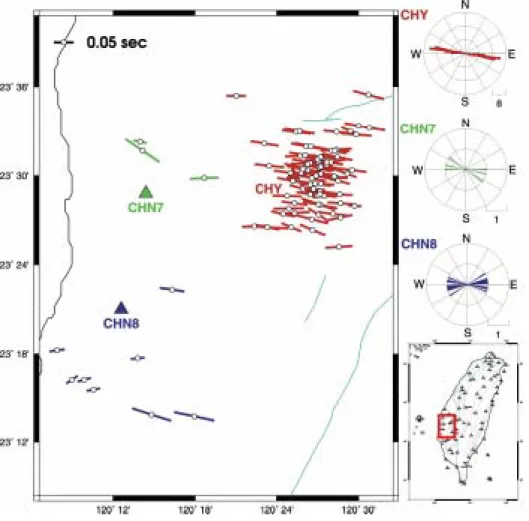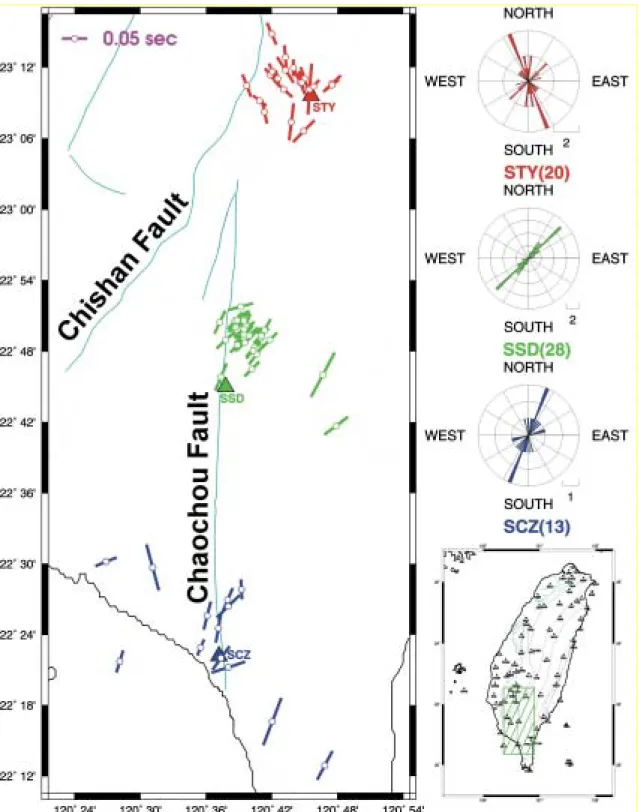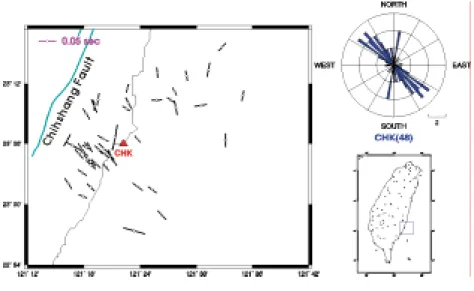行政院國家科學委員會專題研究計畫 成果報告
台灣地殼地震剪力波非均向性研究(2/2)
計畫類別: 整合型計畫
計畫編號: NSC91-2119-M-006-003-
執行期間: 91 年 08 月 01 日至 93 年 01 月 31 日 執行單位: 國立成功大學地球科學系(所)
計畫主持人: 饒瑞鈞
報告類型: 完整報告
報告附件: 出席國際會議研究心得報告及發表論文 處理方式: 本計畫可公開查詢
中 華 民 國 93 年 4 月 23 日
Crustal Shear Wave Anisotropy in Taiwan
一、中文摘要
本研究利用 1991-2000 台灣短週期地震觀測網之資料探討台灣造山帶地殼地 震非均向性之特性。經由地震非均向性之特質,本研究之目的在於探討台灣地殼 地震非均向性之成因。地震剪力波的分離作用(shear-wave splitting) 是地殼內普 遍存在的特性。對上部地殼而言,剪力波分離的快波極化方向 (fast polarization direction) 通常與地殼裂縫的排列方向一致,同時它亦近乎平行於最大應力軸方 向。而快波與慢波間的時間差 (split time) 是與地殼非均向性的程度 (degree of anisotropy) 和裂縫的密度 (crack density) 有關。本研究採用之方法乃配合粒子運 動及波形交互對比法(Rau et al., 2000)來分析剪力波的分離作用。本研究利用之資 料為台灣短週期地震觀測網自 1991 年更新以來,至 2000 年之 1.5 < M < 4.5 地震 記錄。研究結果顯示﹕台灣地區之剪力波分離的快波極化方向呈複雜、非單一方 向性。位於西部平原之地震站之快波極化方向多平行於與 GPS 和地質研究推論 一致之最大應力軸方向。而位於西部麓山帶(含)以東之地震站之快波極化方向則 多呈兩個方向﹕一則平行,一則垂直於區域構造或礦物傾向排列方向。位於東部 海岸山脈的成功站之快波極化方向則呈現西北-東南向而與最大應力軸方向一 致。本研究結果顯示﹕台灣地殼地震非均向性之成因不可單由”大範圍膨脹的非 均向性” (extensive-dilatancy anisotropy, EDA)之理論(快波極化方向平行於最大應 力軸方向)解釋。其他因素﹕如因斷層構造或礦物傾向排列影響所造成之非均向 性亦須考慮。
關鍵詞:地震剪力波的分離作用;地殼非均向性;台灣造山帶
Abstract
Crustal shear wave anisotropy is analyzed in seismograms from local earthquakes (1.5 < M < 4.5) recorded at 75 permanent network stations in Taiwan during the period between 1991 and 2000. We investigate the origin of Taiwan crustal anisotropy by analyzing splitting in recorded shear waves, which can be characterized by a fast polarization direction and a time delay between fast and slow shear waves.
Particle motion analysis and cross-correlation method are applied to estimate the splitting parameters of local shear waves. Clear evidence of shear wave splitting with split times of 0.02 to 0.2 s is found in about 75% of the stations studied. Stations in Coastal Plain, the foreland basin, show consistent alignment of the fast polarization directions that are parallel to the directions of local maximum horizontal compressive stress. Around the Chukou fault in the foothills region, fast shear-wave polarization
directions of over 20 earthquakes recorded at station TWL are normal to the direction of local maximum horizontal compressive stress and parallel to the NE-SW trend of this east-dipping thrust fault. Except TWL, all the stations in foothills show large scatter in measured shear-wave polarizations. In the southern Central Range, two stations with a stable polarization direction of NNE-SSW, which is consistent with the local preferential mineral orientation, are found near the ChaoChou fault system. Two persistent polarization directions of fast shear wave are observed in a station (STY) near the boundary between the foothills and the southern Central Range: NW-SE direction for earthquakes located beneath the foothills and NE-SW direction for earthquakes coming under the Central Range. Fast shear-wave polarization directions of station CHK in eastern Coastal Range are orientated in NW-SE directions that are parallel to the directions of local maximum horizontal compressive stress. Our study indicates that the crustal anisotropy beneath the Taiwan orogen cannot be simply explained by the hypothesis of extensive dilatancy anisotropy (EDA), where parallel alignment of fluid-filled fractures produces the anisotropy.
Other factors, such as intrinsic rock anisotropy caused by preferential mineral alignment and stress-induced cracks or fractures in the vicinity of fault zones may also contribute seismic anisotropy.
Keywords: shear-wave splitting; crustal anisotropy; Taiwan orogen
二、緣由與目的
地震剪力波的分離作用(shear-wave splitting) 是區域地震記錄上經常可觀測 到的一個現象;此現象亦是地殼內普遍存在的特性 (Crampin, 1994)。對上部地 殼而言,剪力波分離的快波極化方向 (fast polarization direction) 通常與地殼裂縫 的排列方向一致,同時它亦近乎平行於最大應力軸方向。而快波與慢波間的時間 差 (split time) 是與地殼非均向性的程度 (degree of anisotropy) 和裂縫的密度 (crack density) 有關 (Crampin, 1999)。所以,地殼地震剪力波分離之研究是提供 區域應力分布與監測應力累積與釋放的良好手段(Tadokoro and Ando, 2002)。
921 (1999 年) 集集大地震前,台灣地殼地震剪力波分離之研究多侷限於小 區域之研究 (Kuo et al., 1994; Chen and Yen, 1998),而未能對台灣整體之地殼地 震非均向性作一評估。在 921 集集大地震之後,為多方面瞭解大地震之發生與地 震地體構造相關之參數,此項台灣地殼非均向性之研究益形迫切與重要。再則,
距中央氣象局地震觀測網自 1991 年更新以來,已有十年之地震資料累積。這些 大量之地震資料,正是提供了台灣地殼非均向性研究之最佳資源。本研究計劃之 目的為探討台灣地殼非均向性的成因。
三、結果與討論
本研究利用之資料為台灣短週期地震觀測網自 1991 年更新以來,至 2000 年之地震記錄。研究結果顯示﹕台灣地區之剪力波分離的快波極化方向呈複雜、
非單一方向性。位於西部平原之地震站之快波極化方向多平行於與 GPS 和地質 研究推論一致之最大應力軸方向(Figure 1)。而位於西部麓山帶(含)以東之地震站 之快波極化方向則多呈兩個方向﹕一則平行,一則垂直於區域構造(Figure 2)或礦 物傾向排列方向(Figure 3)。位於東部海岸山脈的成功站之快波極化方向則呈現西 北-東南向而與最大應力軸方向一致(Figure 4)。本研究結果顯示﹕台灣地殼地震 非 均 向 性 之 成 因 不 可 單 由 ” 大 範 圍 膨 脹 的 非 均 向 性 ” (extensive-dilatancy anisotropy, EDA)之理論(快波極化方向平行於最大應力軸方向)解釋(Crampin, 1994)。其他因素﹕如 因斷層構造 (Zinke and Zoback, 2000)或 礦 物 傾向排列 (Brocher and Christensen, 1990)影響所造成之非均向性亦須考慮。
四、計畫成果自評
本研究計劃旨在(1)建立一完整的台灣地殼非均向性分布圖(楊智龍, 2002);(2)分析大地震前後,剪力波分離隨時間和(或)空間的變化。就第一 個目的而言,本計劃提供地震地體構造一個很重要的參數。它可用來與地震活動 性、地震震源機制、斷層擦痕與斷層分布作一整體性之台灣大地應力分析。就第 二個目的而言,我們可藉由監視地震剪力波分離在大地震前後隨時間的變化,來 探討地殼應力的累積與釋放,而用來測試地震預報的可能性(Crampin et al., 1999)。
五、參考文獻
Brocher, T. M., and N. I. Christensen, Seismic anisotropy due to preferred mineral orientation observed in shallow crustal rocks in southern Alaska, Geology, 18, 737-740, 1990.
Chen, C.-H. and Yen, H.-J., A preliminary study on crustal anisotropy in Chia-Nan area of Taiwan, TAO, 9, 573-588, 1998.
Crampin, S., The fracture criticality of crustal rocks, Geophys. J. Int., 118, 428-438, 1994.
Crampin, S., Calculable fluid-rock interactions, J. Geol. Soc., London, 156, 501-514, 1999.
Crampin, S., T. Volti and R. Stefánsson, A successfully stress-forecast earthquake, Geophys. J. Int., 138, F1-F5, 1999.
Kuo, B.-Y., Chen, C.-C. and Shin, T.-C., Split S waveforms observed in northern Taiwan, Geophys. Res. Lett., 21, 1491-1494, 1994.
Rau, R.-J., Liang, W.-T., Kao, H. and Huang, B.-S., Shear wave anisotropy beneath the Taiwan orogen, Earth and Planet. Sci. Lett., 177, 177-192, 2000.
Tadokoro, K. and M. Ando, Evidence for rapid fault healing derived from temporal changes in S wave splitting, Geophys. Res. Lett., 29, 10.1029/2001GL013644, 2002.
Zinke, J. C. and M. D. Zoback, Structure-related and stress-induced shear-wave velocity anisotropy: observations from microearthquakes near the Calaveras fault in central California, Bull. Seismol. Soc. Am., 90, 5, 1305-1312, 2000.
楊智龍,臺灣地殼剪切波非均向性研究,國立成功大學地球科學系碩士論文,共 115 頁,2002。
Figure 1. Shear-wave splitting parameters of Coastal Plain stations plotted as vectors at epicenters. Fast polarization directions are given by bar azimuth from north.
Delay time is proportional to bar length, as given by scale bars.
Figure 2. Shear-wave splitting parameters of Western Foothills stations plotted as vectors at epicenters. Fast polarization directions are given by bar azimuth from north. Delay time is proportional to bar length, as given by scale bars.
Figure 3. Shear-wave splitting parameters of southern Central Range stations plotted as vectors at epicenters. Fast polarization directions are given by bar azimuth from north. Delay time is proportional to bar length, as given by scale bars.
Figure 4. Shear-wave splitting parameters of eastern Taiwan station CHK plotted as vectors at epicenters. Fast polarization directions are given by bar azimuth from north. Delay time is proportional to bar length, as given by scale bars.



